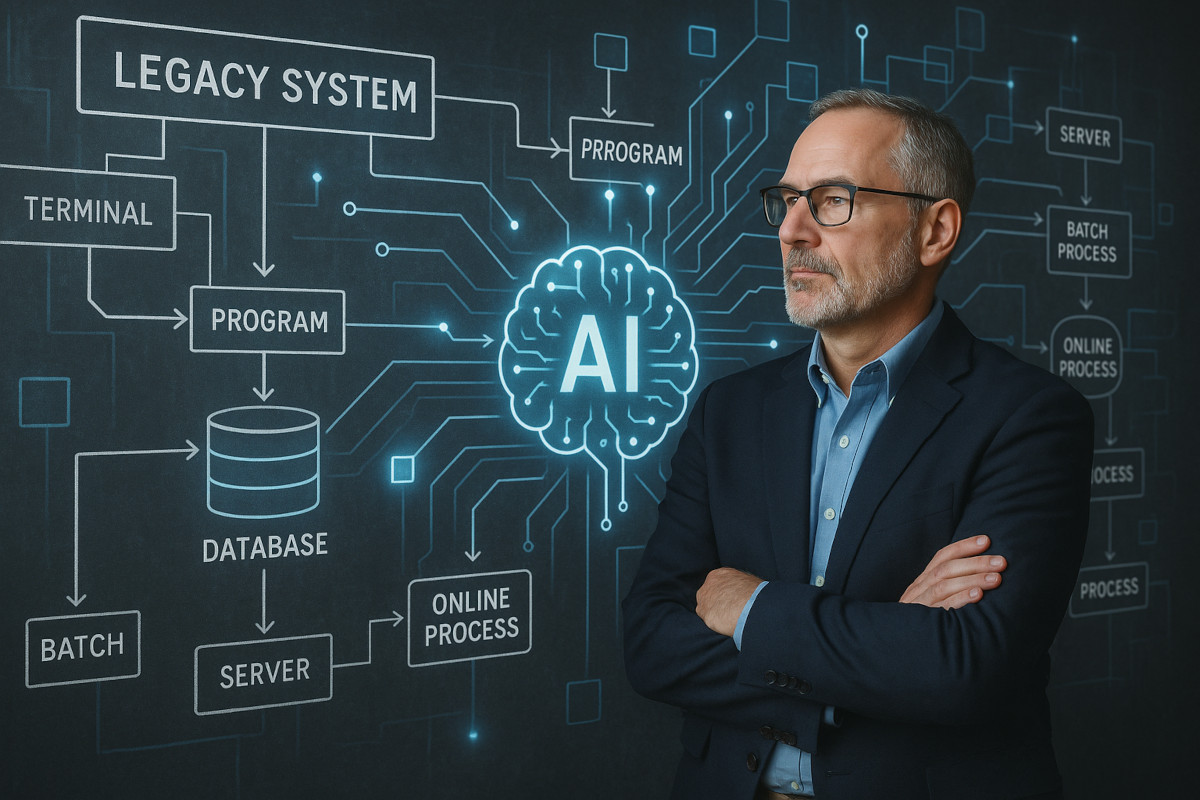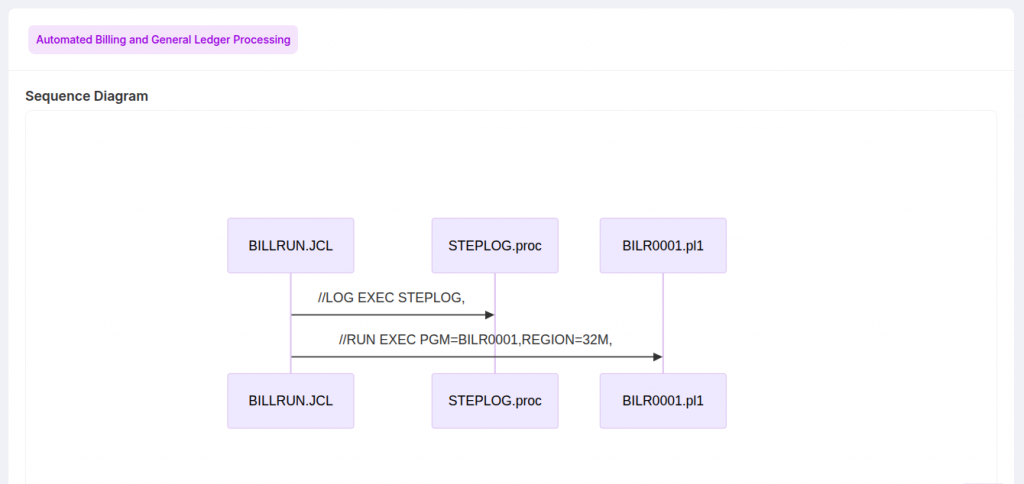
The Backbone of Legacy Systems: Why SMEs Still Matter
In regulated industries like banking, healthcare, and manufacturing, mainframes continue to underpin mission-critical operations. While these systems are robust, their long-term survival often hinges on a relatively small group of Subject Matter Experts (SMEs). These are the individuals who carry decades of accumulated domain knowledge, system nuance, and undocumented logic in their heads — knowledge that was never captured in formal documentation but is essential to system stability.
SMEs are not just technical resources. They are interpreters of business rules buried in COBOL, custodians of operational safety nets like JCL job flows, and guardians of compliance-sensitive processes. When they retire or leave, the risk isn’t merely knowledge loss — it’s operational disruption, audit failure, and modernization paralysis.
Despite the influx of AI and automation, SMEs remain irreplaceable. The real question for enterprise leaders isn’t how to replace them, but how to scale their impact. CodeAura recognizes this distinction. Our platform is designed not to override SMEs but to augment their capabilities — giving them faster ways to analyze codebases, visualize flows, and ensure alignment with business rules and regulatory frameworks.
Modernization without SMEs is a gamble. With them — and with the right tools — it becomes a strategic, lower-risk transformation initiative.
Undocumented Code, Tribal Knowledge, and the Modernization Deadlock
One of the most persistent challenges in legacy environments is the overwhelming reliance on undocumented code and institutional memory. In many mainframe-based enterprises, upwards of 40% of critical application logic remains undocumented, leaving organizations vulnerable to SME bottlenecks. These systems—written in COBOL, JCL, and other niche languages—often reflect decades of patchwork changes, regulatory adjustments, and unstructured growth. The only consistent thread? The SMEs who remember why things were built the way they were.
This tribal knowledge creates a paradox. On one hand, it enables continuity. On the other, it traps modernization efforts in a dependency loop. When every code migration, refactor, or audit trail depends on the availability of a few overburdened experts, scalability becomes impossible.
The result? Projects stall. Costs escalate. And leadership faces the unpalatable choice of deferring transformation or risking non-compliance.
CodeAura breaks this deadlock by systematizing what SMEs know—before that knowledge disappears. Through AI-powered documentation, contextual code analysis, and dynamic visualization, CodeAura reduces the need for SMEs to re-explain the same logic repeatedly. Instead of spending weeks deciphering legacy logic, teams get structured insights instantly, freeing SMEs to focus on guiding architecture, validating logic, and de-risking decisions.
This shift—from tribal knowledge to systematized intelligence—is the foundation for modernization that actually moves forward.
Why Replacing SMEs is Not the Answer—Augmenting is
The narrative that AI will replace legacy system SMEs is not only flawed—it’s dangerous. Mainframe SMEs are not replaceable cogs. They are stewards of systems that process billions in transactions, manage national healthcare records, or coordinate global manufacturing supply chains. No model, no matter how advanced, can intuit decades of tacit business logic, exception handling, or compliance context encoded into legacy systems.
Enterprises that pursue a “rip and replace” mindset—without SME integration—often find themselves facing spiraling project costs, rework, and operational risk. The real opportunity lies not in replacing SMEs, but in augmenting their capabilities with AI.
CodeAura is built around this principle. Instead of sidelining SMEs, the platform works alongside them—automating repetitive discovery tasks, surfacing hidden dependencies, and converting unstructured code into explainable, auditable documentation. It enables SMEs to operate as system strategists, not reactive troubleshooters.
This approach shifts the modernization dynamic. SMEs become force multipliers rather than bottlenecks. Their expertise is captured, scaled, and reused—empowering broader teams and ensuring knowledge resilience even as organizations evolve.
The question for CIOs and CTOs isn’t whether SMEs can keep up. It’s whether the enterprise is doing enough to let them lead with leverage.
From Burnout to Breakthrough: Reducing SME Strain in Documentation
SMEs in legacy environments are often caught in a cycle of reactive firefighting—answering repetitive questions, tracing decades-old logic, and manually documenting systems that were never built for transparency. The cumulative toll? Burnout, knowledge silos, and missed modernization windows.
Documentation, in particular, is a chronic pain point. In many enterprises, SMEs are expected to translate hundreds of thousands of lines of COBOL or JCL into something usable for architects, auditors, or transformation teams. This work is essential—but it’s also time-consuming, error-prone, and mentally exhausting.
CodeAura reimagines this burden as a breakthrough opportunity. By automating core documentation tasks—such as generating flowcharts, interaction diagrams, component relationships, and code annotations—our platform dramatically reduces the time and effort required from SMEs. What once took weeks of manual walkthroughs can now be completed in hours with AI-guided precision.
This isn’t about removing the SME from the loop—it’s about allowing them to focus on high-value analysis rather than repetitive translation. The platform even integrates with tools like Slack, JIRA, and Discord, allowing SMEs to answer system questions contextually without duplicating effort.
When documentation becomes a co-pilot experience rather than a manual slog, SME engagement goes up, stress goes down, and project velocity improves across the board.

From Burnout to Breakthrough: Reducing SME Strain in Documentation
SMEs in legacy environments are often caught in a cycle of reactive firefighting—answering repetitive questions, tracing decades-old logic, and manually documenting systems that were never built for transparency. The cumulative toll? Burnout, knowledge silos, and missed modernization windows.
Documentation, in particular, is a chronic pain point. In many enterprises, SMEs are expected to translate hundreds of thousands of lines of COBOL or JCL into something usable for architects, auditors, or transformation teams. This work is essential—but it’s also time-consuming, error-prone, and mentally exhausting.
CodeAura reimagines this burden as a breakthrough opportunity. By automating core documentation tasks—such as generating flowcharts, interaction diagrams, component relationships, and code annotations—our platform dramatically reduces the time and effort required from SMEs. What once took weeks of manual walkthroughs can now be completed in hours with AI-guided precision.
This isn’t about removing the SME from the loop—it’s about allowing them to focus on high-value analysis rather than repetitive translation. The platform even integrates with tools like Slack, JIRA, and Discord, allowing SMEs to answer system questions contextually without duplicating effort.
When documentation becomes a co-pilot experience rather than a manual slog, SME engagement goes up, stress goes down, and project velocity improves across the board.
Accelerating Decision Velocity Without Sacrificing Accuracy
In legacy system modernization, time is rarely on your side. Regulatory deadlines, escalating maintenance costs, and competitive pressures demand swift action. Yet decisions about code rewrites, component deprecation, or compliance remediation are often delayed—not because of indecision, but because the necessary insight is trapped within outdated systems or overstretched SMEs.
Subject Matter Experts are the linchpin for informed decision-making. But their time is finite, and their workload already immense. Without scalable ways to extract and validate insights from legacy code, even the most capable SMEs can become bottlenecks to progress.
CodeAura addresses this by accelerating decision velocity without compromising on accuracy. Using AI-driven contextual analysis, the platform surfaces real-time insights about system behavior, business rule mapping, and data lineage—empowering SMEs to make strategic calls with confidence.
Instead of poring over raw COBOL or cross-referencing multiple JCL scripts, SMEs can now interact with system knowledge in human-readable formats. Interactive diagrams, rule extraction summaries, and dependency maps provide an immediate understanding of how changes will ripple through the ecosystem.
This means fewer delays in architecture reviews, faster turnarounds on audit responses, and more agile modernization cycles. SMEs remain in the driver’s seat—but with a dashboard that finally matches the complexity of the road ahead.
Ensuring Compliance with Confidence: SMEs as Risk Interpreters
In regulated industries, compliance isn’t optional—it’s existential. Whether it’s HIPAA in healthcare, Basel IV in banking, or FedRAMP in federal systems, non-compliance can result in massive fines, reputational damage, or even operational shutdowns. Yet many legacy environments operate in a state of low visibility and high risk, where compliance readiness depends almost entirely on a handful of Subject Matter Experts.
SMEs are the human bridge between regulatory language and technical implementation. They understand not just what the system does, but why it was built that way, how it supports compliance workflows, and where the latent risks lie. However, when systems lack clear documentation, traceability, or lineage mapping, even the best SMEs struggle to provide timely, auditable responses.
This is where CodeAura steps in. Our platform equips SMEs with tools to interpret, trace, and validate compliance-critical logic—fast. From automated lineage mapping of personally identifiable information (PII), to identifying where legacy logic supports specific compliance clauses, CodeAura translates raw code into regulatory context.
With every change tracked, visualized, and explained, SMEs gain the clarity needed to support internal audits, respond to regulators, and guide modernization without exposing the enterprise to undue risk. And because these insights are system-generated and SME-verified, confidence increases across IT, risk, and executive teams alike.
In short: SMEs remain the compliance interpreters—CodeAura just gives them a much stronger lens.
SME + AI Collaboration: The Winning Formula for Legacy Transformation
The most successful legacy modernization efforts don’t sideline Subject Matter Experts—they amplify them. When SMEs and AI work in tandem, the result is not just faster modernization, but smarter modernization. CodeAura is engineered around this philosophy: pair human expertise with AI-driven automation to unlock a force multiplier effect.
In practice, this collaboration looks like a 2–5x increase in project throughput. Tasks that once required deep dives into arcane COBOL modules—like understanding eligibility rules in an insurance system or tracing the lifecycle of a financial transaction—are now semi-automated. The AI provides structured summaries, logic visualizations, and dependency insights; SMEs validate, refine, and drive the transformation forward.
The benefit is twofold. First, SMEs no longer burn cycles on rote, repetitive tasks—they shift to higher-order problem solving. Second, their decisions are backed by structured system intelligence, reducing human error and increasing modernization confidence.
In one financial services use case, AI-assisted SME collaboration helped reduce code assessment timelines by 60%, while maintaining full audit traceability. In healthcare, it enabled the mapping of legacy claim processing logic to HIPAA compliance mandates in days instead of weeks.
These are not theoretical improvements—they’re operational accelerators. The result is a modernization initiative where speed, safety, and subject matter expertise coexist.
Redefining the Role of SMEs in the Modern Enterprise
The legacy SME of yesterday was often viewed as a necessary dependency—someone to call when systems broke, audits loomed, or modernization plans stalled. But in the modern enterprise, that view is shifting. With the right tools and support, SMEs are no longer just maintainers of the past—they’re strategic enablers of the future.
CodeAura is helping drive that transformation. By offloading the heavy lifting of system discovery, documentation, and translation, we allow SMEs to evolve into roles that are more architectural, more advisory, and more forward-looking. They become critical partners in risk management, innovation planning, and technology transformation—not just keepers of legacy code.
This redefinition is more than semantic. It reflects a deeper organizational imperative: to preserve what SMEs know, extend their influence across teams, and ensure that modernization efforts are grounded in both business context and technical truth.
For CIOs, CTOs, and transformation leaders, the path forward isn’t about replacing SMEs—it’s about repositioning them. With AI as an enabler, SMEs can guide legacy systems into their next chapter—without burnout, without knowledge loss, and without compromising regulatory or operational integrity.
The future of modernization isn’t just technical. It’s human—and it starts by empowering those who know your systems best.
Are you a SME? Let’s Talk! — Schedule a session with CodeAura today.

